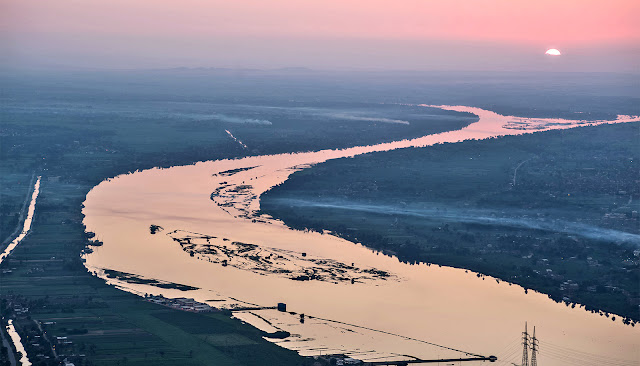Around 60% of the African population lives within a transboundary river basin (Nijsten et al. 2018) whereby conflicts over water are inherently asymmetrical as upstream riparian states influence the quality and quantity of flows for downstream riparians. Navigation over the use of international water has always been embedded in politics over who has rights and whether a country has territorial sovereignty – absolute rights – or riverine integrity – every riparian is entitled. Water is the only scarce resource for which ‘there is no substitute and an overwhelming, constant, and immediate need’ (Wolf 1999:3). The formation of an ‘equitable water-sharing agreement along waterways is a prerequisite to hydro-political stability’ (ibid:3). I will therefore be investigating water in Africa, focalising my research on the relationship between water and food, particularly the effects of dams on food production, to understand the nuances of water and the larger impacts of transboundary water use, because of course, to grow food, you must have water.
The Nile river, the longest in the world, provides 11 states with a supply of water. The population residing in the Nile Basin is forecasted to double by 2050, advancing 1 billion people. The inevitable surge in water demand will significantly stress the variable water supply, further burgeoned by climate change implications, making this critical water resource a valuable case study into the relationship between water and food in Africa (Siam & Eltahir 2017).
Four tributaries of the Eastern Nile Basin provide supplies: the Blue Nile (56%), White Nile-Albert (14%), Atbara (15%) and Sobat (15%) (Habteyes et al. 2015). The Blue Nile provides the main input and yet provides a very seasonal flow of water, which is important to note why the Nile provides an interesting case on navigating water usage.
 |
| Average annual rainfall of the Nile (Source: Nile Basin Initiative) |
A zonation pattern is evident whereby lower regions of the Nile river receive as little as 50mm or less of precipitation. From the confluence with the Atbara River in Sudan, northwards river flow diminishes due to high evaporation in the arid climate. Contrastingly, the highlands of the southward regions of the river receive high rainfall upwards of 1500mm, this being the key input maintaining flow in the Nile. Projections from climate model simulations indicate interannual variability of overall Nile flow may rise by 50% (±35%) (Siam & Eltahir 2017).
North Africa is a water-stressed region, according to Falkenmark’s water stress index (1989), which heavily relies on surface water sources such as the Nile river. Since 1840, 153 dams have been built or are currently being constructed on the Nile. In fact, 97% of Egypt’s water is supplied by the Nile and thus efficient utilisation of the river is vital for them (Gasser & Abdou 1989). This led to the construction of the Aswan Dam which transformed the uncertain flow into a well-regulated supply, increasing transport activity and irrigation for crops in the Nile Valley. Comparing the actual 1997 economy to the 1997 economy as it would have been if historical pre-dam Nile flows had applied, demonstrated an increase of EGP7.1 billion to Egypt’s economy (Strzepek et al 2008).
Dams clearly play an important role in water, especially for irrigation whereby irrigated agriculture leads the geographical distribution of global freshwater withdrawals standing at 69% (Shiklomanov 1999; Wada et al 2011). Whilst I will be focusing on water and food, the politics of water is vital in understanding the effects of dam construction, especially when the water source is as variable as the Nile. In 2011, Ethiopia announced the construction of the Grand Ethiopian Renaissance Dam (GERD), with a reservoir capacity of 74billion m3 of water, equal to more than 40% of Egypt’s total annual Nile supply, providing Ethiopia will the ability to majorly interrupt Egypt’s supply (Gebreluel 2014). The politics of the GERD is imbedded in the capability of Egypt and Ethiopia agreeing on terms for the filling of the GERD reservoir in a way that does not disrupt flows drastically and thus food production.
And so, I will investigate the effects of dam construction on food in Africa which is inherently political due to the fragility of water resources in a continent like Africa. Over the next few posts, I will be focussing on the GERD, and discussions surrounding its possible implications on irrigated agriculture, before investigating the wider politics of water and food within the Nile basin.

Good starting point for your blog. I really like how you have focused your post on conflict and what it means in terms of water and food. Good synthesis of literature. For future posts, try be as concise as possible.
ReplyDeleteVery good use of references as hyperlinks!
I look forward to reading your subsequent posts. I would encourage you to post more regularly!
(GEOG0036 PGTA)
This a great starting entry Maha! I really like how you encapsulate in very few words the shear importance of the Nile for North Africa. Great use of statistics too!
ReplyDeleteHeres a bit of feedback:
- It would be great if you explicitly link water to food, why is water integral for food and why are you studying it?
- It would be good if you give a clear structure of the next blog entries (this can be done at the end) so we the readers know what to expect
- Subheadings would be great to organise your blogs
- A few hyperlinks are missing
Otherwise, I very much enjoyed reading this entry. Best of luck for the next entries
Great introduction! I like how you expressed the importance of dams in the production of food, and how you brought in the other aspects which must be assessed. I look forward to the next :)
ReplyDelete